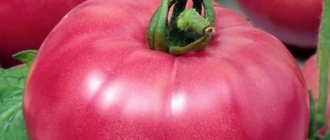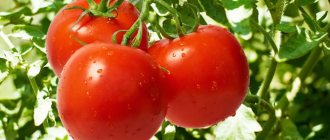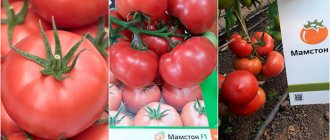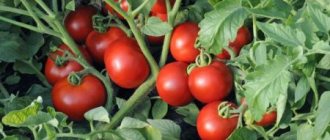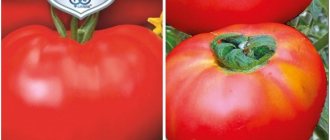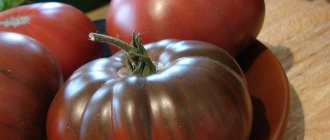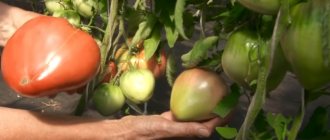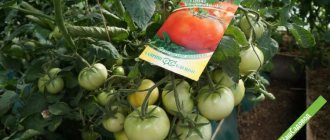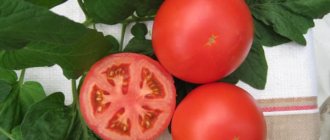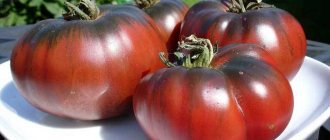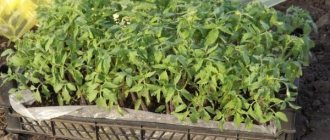Characteristics and description of the variety
Marmande has been one of the most popular in Europe for more than a hundred years. What qualities allowed the tomato to gain such fame?
Subspecies Super Marmande
With the growing popularity, tomato seeds began to be produced in Germany, the Netherlands, Spain, the USA and other countries of the world.
Breeders from many countries worked to adapt the French variety to growing conditions. Thus, in Spain the variety Marmande RAF (resistente a Fusarium) appeared, which means “Marmande, resistant to fusarium.” French breeders decided to “decorate” the old Marmande and brought out the unusually bright Marmande Montpellier.
Dutch breeders recreated and improved the variety, calling it Super Marmande. On the Russian market you can find this and the classic name Marmande.
Distinctive features
This variety is early ripening (75-100 days), semi-determinate (140-180 cm), salad with a classic sweet and sour taste. It is unpretentious in care and grows well on any soil, both in open and closed ground.
Sturdy, strong and compact bushes are moderately resistant to frost and resistant to fusarium, verticillium and a number of other diseases.
Fruit characteristics, yield
The fruits are set in clusters of 4-6 pieces. They are flat-rounded, ribbed, weighing 150-250 g.
The photo clearly shows that the fruits are especially ribbed at the stalk. The pulp of the fruit is fleshy, oily with four chambers. The purpose of the fruit is universal, but it is better to eat everything fresh. Productivity – 9-10 kg per 1 sq. m.
Rules of agricultural technology
Marmande belongs to the category of light and easy-to-care varieties. It is unpretentious to the composition and quality of the soil. It is distinguished by stable high yields even in sparse areas without additional fertilizer.
If it is necessary to increase the volume and quality of the harvest, experts recommend following the rules for growing tomatoes.
- Choosing a location. A place for Marmande is chosen with light, fertile soils. The variety is light and heat-loving. Therefore, areas should be well lit.
- Growing method. Tomatoes are grown by seeding. Seedlings are sown in early March. Hardening must be carried out before transferring to the ground.
- Transfer to the ground. Plants are transferred to unprotected soil in the second half of May. Seedlings are planted in closed greenhouses or under film at the end of April or beginning of May. This method allows you to get an earlier harvest.
- Landing scheme. The distance between bushes should be at least 50 centimeters, between rows 40. Up to 9 bushes are placed on 1 square meter.
- Soil fertilization. The first stage of fertilizers is produced in early spring. Humus is added to the ridges while digging the site. Then the tomatoes are fertilized 2-3 times per season with organic fertilizers.
- Watering. Plants are moisture-loving. They require regular watering. It is carried out in the evening with warm, settled water.
How to grow seedlings
Strong seedlings are the key to a rich harvest. How to grow good seedlings?
Seed preparation
Good seedlings begin with preparing the seeds. Remember that pre-treatment disinfects the seeds and accelerates their germination.
A well-known collector of rare and exotic varieties of tomatoes, a tomato expert who has tested 1,300 varieties of tomatoes, Lyudmila Kodzasova, advises treating tomato seeds with 40° vodka: “vodka awakens, accelerates and disinfects.” She recommends soaking the seeds in vodka for 15-20 minutes, then rinsing them with water and planting.
Belarusian scientist Ivan Russkikh recommends treating the seeds with undiluted brilliant green or chlorhexidine from the pharmacy. Treatment duration is 30 minutes, rinse thoroughly and plant.
Container and soil
Cups of sour cream, mayonnaise, beer, etc. are suitable as containers for growing seedlings. Holes must be made in the containers.
Important! The depth of containers for growing plants must be at least 10 cm in order for roots to develop.
It is easy to buy soil or substrate in a store or collect it under birch trees in the fall.
Before pouring the substrate into containers for planting, large egg or walnut shells are poured into them as drainage. The containers are filled with substrate, not reaching a few centimeters to the edge. Then the earth is compacted and poured with boiling water and a pink solution of potassium permanganate.
Sowing
When planting, pay attention to the timing of fruit ripening and estimate when you are going to harvest. Please note that tomatoes take 10 days to germinate. If you are not going to use additional lighting, it is better to sow in early March.
The seeds are carefully laid out on the prepared substrate and covered with a centimeter layer of soil on top, moistening the soil with water from a sprayer. Cover with a lid or plastic bag until “loops” of sprouts appear.
As soon as the “loops” appear, remove the lids, bags and place the containers with seedlings on the window.
Growing and care
When the seedlings have their second true leaves, pick them. Using a knife or stick, carefully prying up the root along with the soil.
Important! Before picking, water the seedlings thoroughly.
Plants are planted in moist soil, deeply buried, down to the cotyledons. You cannot water from above.
After transplanting, the seedlings are shaded for several days. When the first watering comes, it is advisable to water the plants with a solution of baker's yeast (a pack of baker's yeast, 1 cup of sifted ash, 1/2 cup of sugar, 3 liters of water). The baker's yeast mixture is prepared 3-4 days in advance, as it must infuse.
Seedlings respond well to watering with a mineral water solution: a glass of 1 liter of water.
How to grow tomatoes
Marmande is distinguished by its unpretentiousness in care - the harvest is obtained even on the most meager, lifeless soils. However, the better the conditions and care, the richer and tastier the harvest!
Landing
Before planting, first of all, prepare the greenhouse: wash the walls, burn the threads to which the tomatoes were tied.
The soil in the greenhouse is dug up, freeing it from the roots of the previous plants, and two weeks before planting the seedlings, it is spilled with “Fitosporin”, and a week before - with a solution of boric acid (1 tablespoon per 10 liters of water).
Planting of seedlings in the ground is carried out in stable warm weather. If you want to plant earlier, you will need shelter. Tomatoes are planted at a distance of 0.5 m from each other and 0.4 m between rows, not closer.
Before planting, prepare holes in which ½ bucket of humus (rotted two- to three-year-old horse manure) is placed, which is filled with a raspberry-colored solution of potassium permanganate, and then a tablespoon of potassium sulfate, a tablespoon of superphosphate, ½ cup of ash, a tablespoon of fish meal are added and everything is mixed. .
Place the plant in the prepared hole at an angle of 45 degrees, orienting it from north to south, cover it with soil, compact it, and water it (1 liter of water).
After 10 days, the plants are watered with a solution prepared from 100 g of yeast and 10 liters of water so that the tomatoes grow well and do not stretch.
Care
The most important rules of care:
- Water the plants not often - about once a week (1 liter of water per bush).
- To ensure that tomatoes set well, the seedlings are watered with potassium sulfate (1 tablespoon per 10 liters of water).
- Tomato plants also love foliar feeding with iodine, manganese, boric acid, Epin, and Zircon. Spraying is carried out every 10 days.
- During hot weather, be sure to spray tomatoes with boric acid.
- When the third cluster blooms, add calcium: 1 tablespoon per 10 liters. water.
- Ash is added several times during the season.
- The soil around the plants is mulched with a layer of 8 cm and watered with Fitosporin.
- The lower leaves are torn off.
About the formation of tomato bushes:
Formation of tomato bushes in a greenhouse
Growing Marmande tomato
The Marmande tomato is considered one of the best early varieties of Dutch selection. It is distinguished for its ease of care, increased fruiting in difficult climatic conditions and bright taste characteristics.
Growing Marmande tomato
Brief information about the variety
- Fruits and bush : tomatoes with clearly defined ribs, bright red color and weight 150-200 g. The bush is indeterminate, reaches 1.6-2 m.
- Productivity: 5-7 kg per bush.
- Resistance: resistant to frost and poor soils, to most diseases, especially late blight and verticillium.
- Distribution: planting in open ground is allowed throughout the country.
- Application: tomatoes are suitable for slicing, salads, vitamin juices, canning and processing (ketchups, sauces).
- Planting: the seedling method is used. Planted from the end of April to the last days of May according to the 50x70 cm pattern.
- Soil: light, turf.
- Care: watering - as the soil dries, pinching - mandatory. Feeding - 2-3 times per season with organic compounds.
- Ripening period : early ripening, full maturity occurs 85-100 days after the appearance of the first shoots, fruiting duration is from July to September.
Features of cultivation and possible difficulties
Regular, moderate watering (excess moisture leads to destruction of the root system).
To prevent the fruits from cracking, make sure that the soil is evenly moistened. How to achieve this? First of all, mulching the soil. Mulching protects against overheating and moisture remains in the soil longer.
If, nevertheless, the soil is very dry, then water the bushes many times intermittently, without flooding. Watering is done with warm, settled water directly under the bush, no more than 1 liter.
During fruit ripening, watering is minimal.
The nuances of growing in open ground and in a greenhouse
When choosing a growing site, please note that the soil on which other nightshades (eggplants, peppers) grew is unsuitable for growing tomatoes.
When planting tomatoes, add compost, peat or rotted manure to the planting holes (fresh manure burns the roots of the plants).
Planting density – no more than 5 plants per 1 sq. m. Water with warm, settled water.
Despite the fact that the bushes of this variety are compact, they need to be tied up, as the branches can break under the weight of the harvest.
Tomato variety Marmande must be planted throughout the growing season. The best yield is achieved when the bush is formed into two or three stems.
During extreme heat, tomato flowers in the greenhouse become sterile, so it is necessary to reduce the temperature in the greenhouse: cover the top of the greenhouse with lutrasil so that the sun does not heat, open the doors and windows.
Tomato Marmande
photo author Evgeny Balashov
Description and characteristics of the Marmande tomato variety, reviews, photos
The original name of the tomato is Marmande .
An early, semi-determinate, productive tomato variety for greenhouses.
The height of the bush is up to 150 cm; it requires tying to a support and pinching. The best harvest was obtained when the plant was formed into 2 and 3 stems.
Basic qualities of fruits
photo by Valentina Redko
The fruits are round, flattened, with slight ribbing, red in color at maturity, weighing 150-250 grams, tasty, sweet, tender. These tomatoes are well suited for fresh consumption and juicing.
Features of growing Marmande tomatoes, planting and care
We recommend sowing the seeds of this tomato for seedlings 60-65 days before the intended planting in the ground. Seedlings dive at the stage of two true leaves. When planting seedlings in a permanent place per 1 sq. It is recommended to place up to 3 plants per meter of land.
Further care for tomatoes consists of timely watering, fertilizing with complex mineral fertilizer, pinching and preventive measures to protect against diseases and pests.
In other catalogs this variety may be called Super Marmande .
Formation of a tomato into 1, 2, 3 stems on video
If you have grown Marmande tomatoes, please leave feedback about them in the comments. If possible, attach a photo of these tomatoes to your comment. This will help many gardeners objectively evaluate this variety and decide whether they should take up space in the greenhouse or not. Thank you!
Harvesting and application
The first fruits are harvested 75-100 days after seed germination. The variety is early ripening. Since the fruits are dense, strong, they tolerate transportation well, are shelf-stable, have an attractive presentation, and are therefore good for industrial cultivation.
The fruits of the variety are sweetish and sour and have a universal purpose. The best use is processing into tomato juice. Fans of tomato jam also like this variety. In France, it is stuffed with soft cheese and baked in the oven.
Delicious recipe:
Marmande with cheese
Advantages and disadvantages of the variety
The advantages of the Marmande tomato include:
- traditional, classic sweet and sour tomato taste;
- aroma;
- attractive appearance;
- easy to transport;
- long-term preservation of fruits;
- early ripeness;
- low maintenance requirements;
- resistance to many diseases and pests;
- productivity;
- This is not a hybrid, which makes it possible to collect the seeds yourself.
The disadvantages of the variety include the need for fertilizing and garter.
Farmer reviews
Vegetable growers call Marmande a lucky find. Tomatoes are used for fresh consumption and canning. According to summer residents, this is the best variety for making tomato juice - it turns out thick and moderately sweet. Some complain about uneven ripening. Large fruits, in their opinion, ripen only at the bottom, and the upper clusters do not have time to ripen before frost.
The famous tomato collector Valentina Rarely writes: “The French beauty Super Marmande has earned many positive reviews among Russian farmers.
Everything about it is perfect – the taste, the size, and the cultivation features.” Private collector Anna, Moscow: “Not a bad tomato, even if you want to grow it for sale.
The fruits are elastic and dense, do not crack and are perfectly preserved. During the growing period, regular fertilizing with fertilizers is important, and basic agricultural practices are also required.” Zhanna, Moscow region: “Bushes 70-80 cm high. Delicious sweet tomatoes 100-150 g each. Productivity above average. Extended fruiting. Those above average are affected by late blight.”
Silva, Moscow region: “I’ve been involved in tomatoes for a long time, growing both varieties and hybrids. Among the low-growing tomatoes, my favorite is Marmande. The harvest is excellent every year. The fruits are large and very tasty. It is from them that I make the very first salads. I harvest before autumn, as the tassels ripen gradually. I advise you to plant at least 2-3 bushes.”
Vladimir, Far East: “I don’t garden; I buy tomatoes from my neighbor in the country. Once I saw fruits of an unusual shape. These were Marmande tomatoes. I took it for testing. Now I buy them every year. Delicious, sweet, meaty. Salads made from them are simply delicious.”
Care
The productivity of tomatoes directly depends on compliance with the rules of care, which do not cause difficulties even for beginners. Water the plantings moderately to prevent moisture from stagnating at the roots.
The characteristics of the variety indicate that the plant tolerates minor drought painlessly, in contrast to heavy watering. Moisten the soil near the roots so that moisture does not get on the foliage.
The crop requires loose soil, so it is weeded after each watering. The procedure will destroy weeds, potential reservoirs of pests and pathogenic spores, and provide oxygen to the roots of the plant.
Tomatoes are prone to forming aerial roots, so the bushes must be earthed up. This will direct the plants’ forces to increase the root system and increase their fruiting.
The Marmande variety tomato does not require mineral fertilizers. It is fed exclusively with organic matter, which includes an infusion of mullein, green grass, solutions of boric acid, iodine, and potassium permanganate. Nutrients are added 2-3 times per season.
TOMATO MARMANDE. Description of the variety
Tomato Marmande
Tomato.Tomato.Marmande.Sweet Marmande
